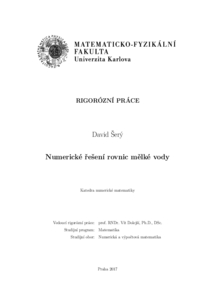Numerické řešení rovnic mělké vody
Numerical solution of the shallow water equations
rigorózní práce (UZNÁNO)

Zobrazit/
Trvalý odkaz
http://hdl.handle.net/20.500.11956/92784Identifikátory
SIS: 193627
Katalog UK: 990021592620106986
Kolekce
- Kvalifikační práce [11978]
Autor
Vedoucí práce
Oponent práce
Felcman, Jiří
Fakulta / součást
Matematicko-fyzikální fakulta
Obor
Numerická a výpočtová matematika
Katedra / ústav / klinika
Katedra numerické matematiky
Datum obhajoby
12. 10. 2017
Nakladatel
Univerzita Karlova, Matematicko-fyzikální fakultaJazyk
Čeština
Známka
Uznáno
Klíčová slova (česky)
rovnice mělké vody, numerická simulace, hyperbolické rovnice, nespojitá Galerkinova metodaKlíčová slova (anglicky)
shallow water equations, numerical simulation, hyperbolic equations, discontinuous Galerkin methodPráce se zabývá numerickým řešením parciálních diferenciálních rovnic popisujících proudění tzv. mělké vody, kde zanedbáváme toky ve svislém směru. Tyto rovnice jsou hyperbolického typu 1. řádu s reaktivním členem daným topologií dna. Výsledný systém rovnic diskretizujeme pomocí impli- citní časoprostorově nespojité Galerkinovy metody (STDGM). V literatuře se obvykle užívají explicitní techniky, implicitní STDGM je vhodná přede- vším pro adaptivní metody, jelikož přirozeně umožňuje použití různých sítí na různých časových hladinách. V této práci odvodíme příslušnou metodu a adaptivní algoritmus. Nakonec prezentujeme použití metody na několika testovacích úlohách. 1
The thesis deals with the numerical solution of partial differential equati- ons describing the flow of the so-called shallow water neglecting the flow in the vertical direction. These equations are of hyperbolical type of the first or- der with a reactive term representing the bottom topology. We discretize the resulting system of equations by the implicit space-time discontinuous Ga- lerkin method (STDGM). In the literature, the explicit techniques are used most of the time. The implicit approach is suitable especially for adaptive methods, because it allows the usage of different meshes for different time niveaus. In the thesis we derive the corresponding method and an adaptive algorithm. Finally, we present usage of the method in several examples. 1
